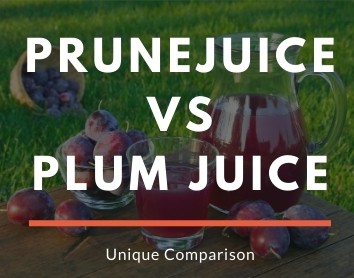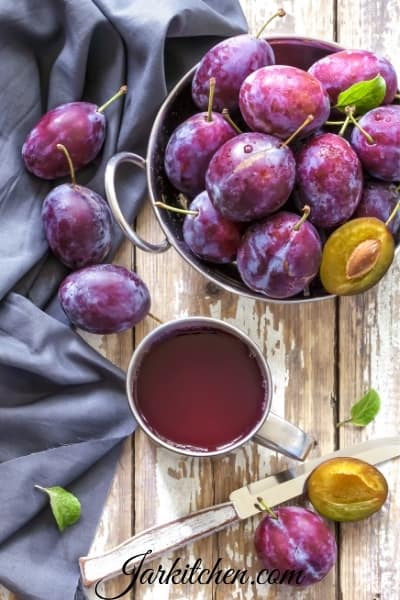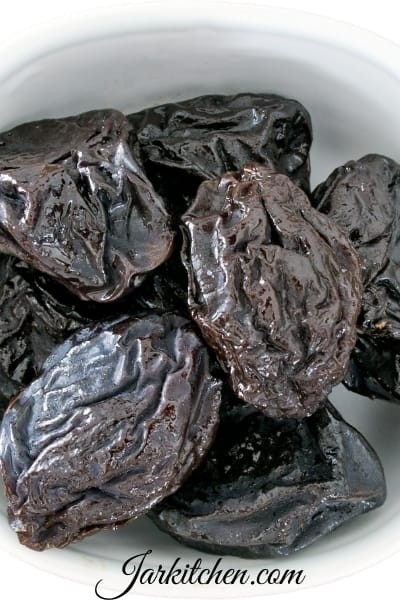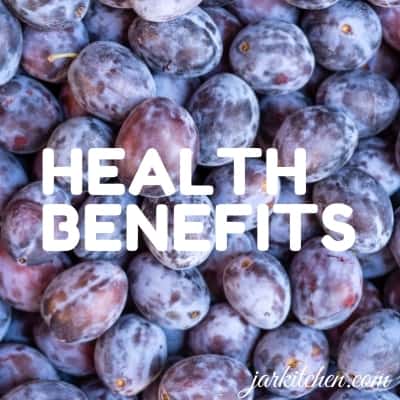Table of Contents
It is really difficult to compare prune juice vs plum juice. Is not it? I don’t even think the difference between prune and plum is well known. If you are wondering about the difference between prune juice and plum juice, today is the time to learn. If there are any differences, this is probably due to the benefits, right? They’re both plums after all? However, although the two juices technically come from plums, there are important differences between them.
Prune juice is naturally made from sugar-heavy prunes. Plum juice is made with fresh plums that are never dried. Different juicing methods and different types of plums will alter the health benefits as the fruit becomes the juice.
Prune juice basically acts as an effective probiotic. It’s completely natural. That’s why many people drink it as a bowel regulator. Plum juice also contains fiber, but its fibers are not as effective as prune juice. That’s why people are unsure about which prune juice and plum juice to drink.
If you want to learn more scientific knowledge about Plum, check out wikipedia.
Looks simple, right? But it’s a little more complicated than that.
This short but concise guide aims to inform you about the similarities and differences between prune juice and plum juice. So you can decide for yourself which one is best for you. You will learn the benefits and recipes of each.
Plum Juice and Prune Juice for Constipation
Is plum juice good for intestines? Is it a laxative? Prune juice is known for its high fiber content. A fit of constipation plum juice vs prune juice for constipation. Also, prune juice and plum juice controversies know this well.
Yet many people aren’t even aware that prune juice is loaded with antioxidants. They see it as a juice for older people. They are also unaware that it is healthier than plum juice, the fruit it originally came from.
But, some people don’t like the taste of prune or plum juice. The following tips can help make plum juice taste better so you don’t miss out on all the health benefits.
You can mix it with other juices.
You can add a small amount of sugar, honey, or other sweeteners.
Icy and cold prune juice usually tastes better than hot.
You can use prune juice in muffins to add texture and flavor.
You can try spices like cinnamon, nutmeg, or a small amount of coriander.
Be bold and change the flavor with hot spices like red pepper or cumin.
Differences Between Prune and Plum, Prune Juice vs Plum Juice
In general, prunes are just a prune. But prunes are being renamed “dried prunes” in some regions to do good marketing. Plum and prunes are the same fruits of the same kind. However, not all plums will be prunes. There are over two thousand plum varieties (types) in the Prunus genus. About a thousand of them are for drying purposes. The rest is the plump and juicy type you see in the grocery store. They are using for cooking or eating fresh

What is a Vitamin Difference?
For example, plums contain 13 percent vitamin K while prunes contain 87 percent vitamin K. Plums also contain vitamin C, vitamin A, iron, potassium, thiamine, riboflavin, calcium, vitamin B6, and niacin. Prunes are high in fiber, which adds volume, fills you up quickly, and keeps your blood sugar levels even.
If you want to eat plums dried, it may be a bit of a problem to remove the seeds. If you also use prunes for juicing, you should first remove the seeds or buy pitted prunes. Fresh plums always contain seeds, so you need to remove them yourself before juicing. Still, removing the seeds is not an exhausting process. Am I wrong?
You can usually distinguish it from fresh plums or prunes by looking at the skin. Prunes are dark blue or purple when ripe. Plums can have a variety of colors. It ranges from red to light purple and all hues in between.
And finally, shape matters. Prunes are usually oval, while plums can be round or heart-shaped. Prunes are not common in stores, but they are not impossible. Knowing the shape and color can help you choose the right fruit.
All of these are important, but the biggest difference is in sugar content. Prunes have a much higher sugar content than regular plums. It is natural sugar, but some prunes have added sugar; check the package. On the other hand, all this natural sugar helps prunes without fermenting. You may be asking that what do these have to do with prune juice vs prune juice? It has a lot to do! Come on, let’s see.
Nutrition Facts per 8-Ounce Serving
Iron 17%Percent Daily Values are based on a 2000 calorie diet.:
Plum Juice:
- Calories 122.5
Total Fat 0g - Saturated Fat 0g
- Polyunsaturated Fat 0g
- Monounsaturated Fat 0g
- Cholesterol 0mg
- Sodium 0mg
- Potassium 252mg
- Total Carbohydrate 30.5g
- Dietary Fiber 0.3g
- Sugars 29g
- Protein 0.3 g
- Vitamin A 2.1%
- Vitamin C 242%
- Calcium 0.9%
- Iron 8.5%
Prune Juice:
- Calories 182
Total Fat 0.1g - Saturated Fat 0g
- Polyunsaturated Fat 0g
- Monounsaturated Fat 0.1g
- Cholesterol 0mg
- Sodium 10mg
- Potassium 707mg
- Total Carbohydrate 45g
- Dietary Fiber 2.6g
- Sugars 42g
- Protein 1.6 g
- Vitamin A 0.1%
- Vitamin C 17%
- Calcium 2.4%
Prune Juice vs Plum Juice
Now also prune juice vs. Let’s look at the differences in plum juice.
Nutrients
Plums are fresh, juicy fruits. They contain nutrients, vitamins, and antioxidants. They contain lots of fiber when eaten fresh. Some juicing methods can also capture some of this important fiber. Because they have such high water content, plums are easy to dehydrate at home. The disadvantage of plum juice is sticky beans. But a sharp knife can handle this quickly.
On the other hand, all the moisture is removed from the prunes. This concentrates similar nutrients and antioxidants in a denser package. Unfortunately, the drying process can reduce or eliminate some vitamins. Also, juicing at home can be a little more difficult when there is no moisture in the fruit.
One advantage of squeezing prunes is that the seeds are easier to remove with just your fingers. Isn’t it better? Some prunes come already seedless so you can start juicing directly. Now the topic is prune juice vs. Let’s look at the differences between plum juice:
Taste
Since prunes are naturally sweeter than other types, prunes will taste sweet. All this sweetness passes into the juice, making the prune juice tastier. Some people don’t care about taste, but this can be fixed. Read on for tips on this.
Plum juice is tangy and sweet. It’s like biting a fresh, crunchy plum from a glass of prune juice. It’s noticeably less sweet than prune juice, but you can still get a nice amount of natural sugar in a glass of fresh plum juice.
If it doesn’t suit you, you can always change the taste of plum or prune juice. Just add another liquid or juice, spice, or other flavorings. Get creative with your blends!
Tissue
In my experience, plum juice has a lighter texture than prune juice. Straight prune juice tends to be thicker. If you don’t like this, the texture can be changed by adding other liquids. You can also change the texture by adding prunes or plums to smoothies.
Health benefits
Although prunes and plums come from the same fruit, the benefits of juices differ.
Prune juice, for example, is much higher in potassium: 707 mg compared to 252 mg in plum juice. Potassium provides a great boost to your health by protecting against stroke and osteoporosis. It also helps reduce blood pressure and water retention.
Plum juice is excellent in its vitamin C content. At 242% of the daily recommended value, it’s a true powerhouse to heal your body. Vitamin C helps your body absorb iron, is good for your bones and skin, and can protect you against heart disease. This amazing antioxidant can even help prevent certain types of cancer.
For those who keep an eye on their carbohydrate intake, it should be noted that prune juice contains more sugar and therefore more carbohydrates than plum juice. If you are making your own plum or prune juice, you can control the amount of added sugar. Personally, I think both juices are very sweet with nothing added, but feel free to play around and find your perfect mix.
Fiber is essential for the body. Luckily prune juice and plum juice contain some fiber. If you are making your own juice, you can control how much to add again.
Calcium is an important part of a healthy diet, and prune juice comes first in this category. With 2.4% of your daily calcium, prune juice contributes to bone health and reduces your risk of osteoporosis. Also studies have shown that calcium can also protect you against cancer and high blood pressure.
Conclusion
Here you have it! Now that you know the differences between prune juice and plum juice, you can start by spreading the knowledge among your friends and colleagues! If they are into cooking or healthy living of course… Otherwise, it would be not logical to come up with the topic “prune juice vs plum juice” in the middle of a conversation out of nowhere. Hey, if you are wondering what the benefits of pomegranate juice are, check out our article in Juicing!

This is Berk from the JarKitchen Team. I am a Mechatronics Engineer and I like cooking in my spare time. By bringing my engineering background into the business, product reviews are a specialty for me. During my travels across Europe, I have learned/tested many recipes and now I plan to bring them to you here!









